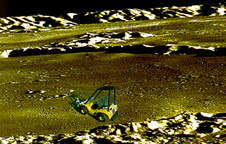Reference project: GINGER (Guidance and Into-the-Ground Exploration Radar)
Development of a Wide Band Radar for the demonstration of a technology for use on planetary rovers. (Center frequencies GPR: 800MHz, NAV: 10GHz)
Customer: ESA (European Space Agency)
The multi-functional Radar for Planetary Rovers was the first project of the Swiss RST on GPR. It marks the basic development for GPR which has been enhanced by the German RST.
This Radar provided the following functions:
1. Forward looking Obstacle Detection
2. Ground Penetration Radar
3. Rover Speed Measurement
Under the acronym GINGER - Guidance and Into-the-Ground Exploration Radar - a new Radar development was started by the European Space Agency in 1994.
This Radar was aimed to support piloting of a planetary Rover by medium resolution imaging of the surface in front and, at the same time, to penetrate dry surfaces exploring the subsurface layer structure beneath the Rover. The idea to combine two totally independent functions of a Radar was born when it turned out that the Radar principles behind these functions were generally identical, the only major difference being measurement frequency.
The penetration function needs frequencies as low as possible, whereas the piloting function desires frequencies as high as possible. Therefore, it was decided to use the intermediate frequency level of the piloting Radar for GPR (Ground Penetration Radar) purposes creating a multi-function Radar.
This RADAR was tested in 1998 under conditions representing Moon and Mars surfaces as good as possible. Guidance sensors were tested in GEROMS, the CNES Mars and Moon Rover test range. Ground penetration testing was performed at the University of Freiberg and, most spectacular, at 800m depth beneath the Earth surface in the salt mine in Borth.

